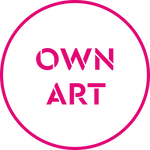With whistles at the ready and fists in the air, we’re delighted to announce a new artwork from Ryan Callanan AKA RYCA has just dropped at Enter Gallery.
The Elements of Acid House is a vibrant homage to defining motifs from the dance music movement, and is available exclusively at Enter Gallery. Here is everything you need to know about the new piece, and some background on the rave scene that inspired it.
The Elements of Acid House
In this exclusive giclée print, RYCA pays tribute to counter culture, this time the acid house movement of the late 80s and early 90s.
The artwork will whisk you back to nights dancing to pioneers of the movement, Danny Rampling and Paul Oakenfold. It will summon the elation felt at being one of the lucky ones granted access to Shoom – the 300-capacity dance night held in a gym basement in Southwark that’s credited with kick starting the rave scene. And will let you relive the delicious anticipation of congregating in service station carparks, waiting for the location of that night’s rave to come through on a dedicated party line.
Inspired by Pop Art
The Elements of Acid House is the latest of RYCA's works to be inspired by Godfather of Pop Art, Peter Blake - demonstrating the ingenuity of the British icon, and his enduring influence on the work of contemporary artists like RYCA.
First we saw RYCA's Hip Hop Ingredients trilogy, which was a play on Blake's American Trilogy. This exclusive new piece draws its inspiration from Blake's hugely-popular Sources of Pop series.
The ‘Second Summer of Love’

One of the elements of the artwork is an image depicting 1988. This was the year that acid house swept the nation, and house music (and ecstasy) transformed British youth culture forever. RYCA includes nods to the spread of this love drug in the artwork, with a white dove (a popular ecstasy pill of the time), a bottle of water and a stick figure ‘tripping on e’.
Of course, The Daily Mail was quick to offer an opinion on the rave scene, dubbing it; ‘the biggest threat to the health and welfare of Britain’s youngsters since the crazy drug cult of the 1960’s.’
This quote led ravers to christen 1988 ‘the second summer of love’ in homage to the hippy movement that rose up in San Francisco in 1967. To the ravers, 1988 was just as significant a moment, with a specific type of music, people and drug coming together to change the culture of their country.
Speaking of the year that was 1988, DJ Paul Oakenfold explains the state of mind of the youth at that point in time:
‘Times were so hard in ’88, you know. You had Margaret Thatcher closing down the mines and the steel and all that. It was really tough. But acid house changed that. Suddenly you could go to a place and express yourself through music. You felt like you were part of something really special.’
Loved up
Another element of the piece RYCA fans will recognise from his oeuvre is the colourful beating heart. This image brings with it many connotations; its resemblance to the flyer art for the Shoom club night; the reminder of how it feels to dance your heart out; and thirdly, the feeling of loving and appreciating every single person that’s dancing beside you.
George Georgiou, the designer behind Shoom’s logo, describes the love that defined the movement:
‘It was like our punk. It completely changed how people acted. You suddenly had football hooligans filling up clubs all loved up, hugging each other. You also saw celebrities dancing alongside teenagers from working-class neighbourhoods, bankers alongside students, and no one cared.’
A curb on ‘anti-social behaviour’

1980s Britain was the age of Maggie Thatcher – and one of her proudest achievements was the M25 motorway, which is also given a shout out in the piece.
Deeming it ‘a road of which we can all be proud’, at the time the motorway was a symbol of British engineering designed to open up London to the Home Counties and connect it to the ports.
One thing the commercially-minded PM didn’t anticipate was how the orbital motorway would fuel the rave scene. The motorway allowed revellers easy access to the countryside where huge illegal parties were thrown in rural locations, where it was much more difficult for police to shut things down.
Ever the party pooper, it wasn’t long before The Criminal Justice and Public Order Act was introduced in 1994 – a moment RYCA includes in his piece. The act of parliament mandated greater penalties for ‘anti-social’ behaviours, and gave police additional powers to shut down unlicensed parties and music events that were ‘characterised by the emission of a succession of repetitive beats’ – a vindictive and very obvious swipe at the UKs illegal rave scene.

Thanks for the memories
Whether you were part of the movement, or were drawn to acid house later in life, The Elements of Acid House is a perfect celebration of this subgenre, defined by repetitive beats (on the Roland TB-303 Bass Synth), sweaty hugs with new friends, and the feeling of being part of a special moment in time where it didn’t matter who you were or where you came from – all that mattered was the music.
The Elements of Acid House is exclusively available at Enter Gallery now.





